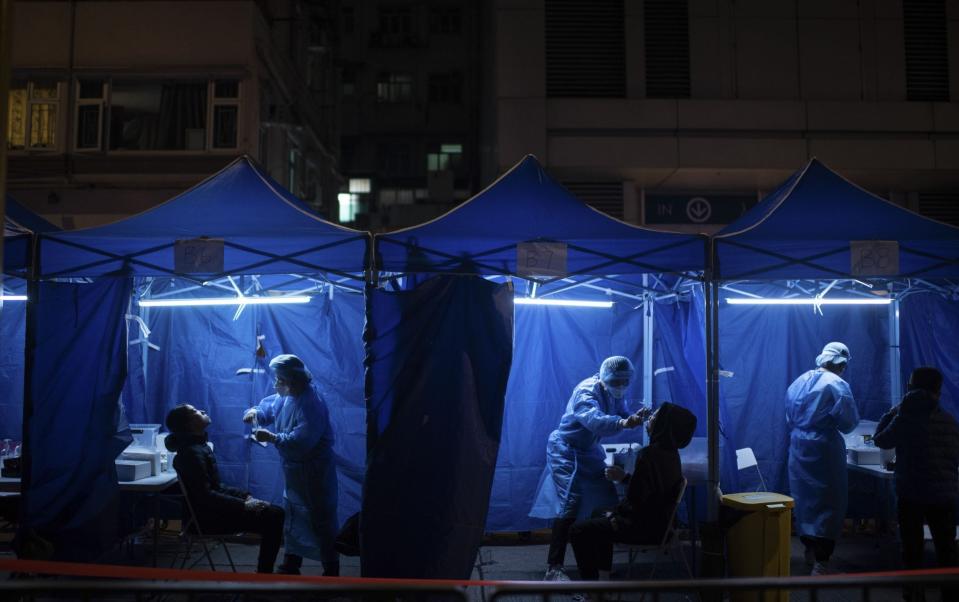How a little-known London start-up predicted China’s deadly Covid outbreak

As China’s coronavirus outbreak escalated and Beijing’s official statistics became increasingly unbelievable, the White House phoned a London-based startup that, prior to 2020, was known to only the most ardent of data geeks.
The Biden administration “had obviously seen our data” and reached out to “understand our models and assumptions,” says Dr Matt Linley, a senior director at Airfinity, a now world-leading source for tracking the spread and trajectory of Covid-19.
The data in question, published in November after China started dismantling its zero-Covid policy, warned that up to 279 million people would be infected, leading to more than 1.3 million deaths, if the country’s restrictions were suddenly lifted.
The estimates looked inflated, but once the nation’s draconian measures ended, it seemed that Airfinity had been right: reports quickly emerged of over-run hospitals; high-profile celebrities started dying; the virus appeared to be on the rampage.
Throughout this, China kept quiet. In its requests for data, clarity and assurances, the western world was met with a wall of silence, making it impossible for governments like the UK and US, with their armies of prestigious scientists, to understand what was happening.

Yet Airfinity, a team of no more than 20 people when the pandemic started, predominantly based in Britain, was able to track and forecast an outbreak in a country on the other side of the globe. So how did it do it?
“We weren’t starting from scratch,” says Dr Louise Blair, senior director of analysis and insights, whose colleagues now number 120.
“The fact that we had tracked all epidemiological data, as well as the impact of different policies and vaccinations on the spread of diseases through many different countries, and many different zero-Covid countries, allowed us to do scenario modelling of what could happen in China following the easing of restrictions.
“We already had a database of all that information that we are able to use for modelling.”
She added that the company’s focus on alternative data sources – including social media, local news reports, crematorium notices and hospital capacity – was also critical to calibrate models and adjust them to take into account regional differences.
“So what we did is comb through literature and previously, studies have highlighted the capacity of certain crematoriums in China,” says Dr Blair. “So when local media reported that crematoriums were overwhelmed, we could put a number on that.
“We also looked at drug demand – we were seeing lots of basic medical, paracetamol for example, selling out in different areas – to not only identify hotspots, but to give us an idea of hospital demand in the area as well.”
Jumping on the data bandwagon
Airfinity also took into account China’s jabs. With major gaps in vaccine take-up, especially among the elderly, the company concluded that between 1.3 and 2.1 million people would die once zero-Covid ended.
When restrictions were eventually lifted, the company then published two main forecasts: the first, in late December, suggested there would be two waves – an initial one in cities in January, followed by a second peak in March as the virus reached rural areas.
But by mid-January, Airfinity updated its projections. The virus was spreading quicker than anyone realised, which would likely cause a longer single wave, putting “increased pressure on hospitals and crematoriums and therefore also potentially a higher case fatality ratio”.
Although official statistics remain patchy – China says 121,144 people have died from Covid – Dr Blair is confident that the company’s models “were well within the range of what actually happened”.
“Movement was the one that had the biggest impact in terms of changing our assumptions about how it spread from urban to rural populations … but after we adjusted our initial assumptions we were in the right ballpark,” she says.
Airfinity has roughly 100 clients – including a “number of western governments”, such as the UK – who were already receiving realtime pandemic updates at the end of 2022. But after the firm shared their data on China more broadly, the White House called.
“They were trying to understand the situation, along with many other governments, and they just wanted a clearer idea of what we’d done, and how or if they could use our numbers for their own internal decision-making,” says Dr Linley.

However, Airfinity’s approach is not new. Researchers and international organisations have been modelling disease outbreaks for decades. But with demand for this type of data growing, many others are now starting to jump on the bandwagon.
Take BlueDot, a Canadian firm which uses AI to scour the internet for early signs of influenza-like outbreaks, or the Public Health Company in the US, which forecasts epidemics, offers public health advice and creates risk assessments for its clients.
But Rasmus Bech Hansen – who in 2015 founded Airfinity, which also tracks advances in cardiovascular disease, rare illnesses and new treatments – said he would like to see more companies publishing their analysis and models for public use.
“What was happening in China – well, first of all, there were a lot of people suffering and dying and I think it’s important for the world to have that information and be aware of the real risks,” he said. “But accurate data on real disease levels … is also key to inform decisions.”
This was especially true for the global economy, considering “China is so integral” to the international supply chain.
“So for those two months,” says Mr Hansen, “I think the real disease level [provided by Airfinity] was one of the most important pieces of information out there.”
Protect yourself and your family by learning more about Global Health Security

 Yahoo Sports
Yahoo Sports 